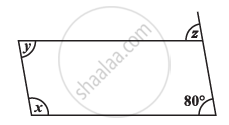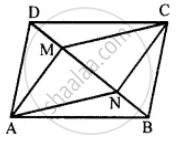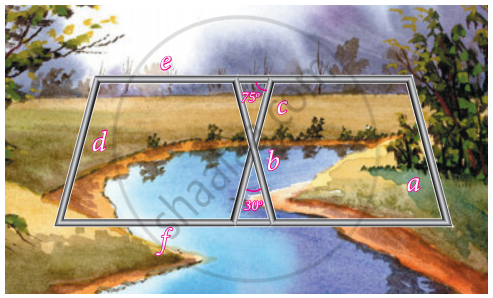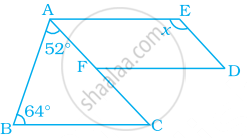Advertisements
Advertisements
प्रश्न
Consider the given parallelograms. Find the values of the unknowns x, y, z.

उत्तर
Since x + 80° = 180° ...[Sum of adjacent angles is 180°]
x = 180° − 80° = 100°
Also 80° = y ...[∵ Opposite angles are equal in a parallelogram]
And x = 180° − z ⇒ 100° = 180° − z
⇒ z = 180° − 100° = 80°
Thus x = 100°, y = 80° and z = 80°
APPEARS IN
संबंधित प्रश्न
Can a quadrilateral ABCD be a parallelogram if ∠D + ∠B = 180°?
The given figure shows parallelogram ABCD. Points M and N lie in diagonal BD such that DM = BN.

Prove that:
(i) ∆DMC = ∆BNA and so CM = AN
(ii) ∆AMD = ∆CNB and so AM CN
(iii) ANCM is a parallelogram.
Iron rods a, b, c, d, e, and f are making a design in a bridge as shown in the figure. If a || b, c || d, e || f, find the marked angles between d and e
Iron rods a, b, c, d, e, and f are making a design in a bridge as shown in the figure. If a || b, c || d, e || f, find the marked angles between d and f
Which of the following is a property of a parallelogram?
The angle between the two altitudes of a parallelogram through the same vertex of an obtuse angle of the parallelogram is 30°. The measure of the obtuse angle is ______.
ABCD is a parallelogram. Points P and Q are taken on the sides AB and AD respectively and the parallelogram PRQA is formed. If ∠C = 45°, find ∠R.
In parallelogram ABCD, the angle bisector of ∠A bisects BC. Will angle bisector of B also bisect AD? Give reason.
In the following figure, FD || BC || AE and AC || ED. Find the value of x.

Construct a parallelogram HOME with HO = 6 cm, HE = 4 cm and OE = 3 cm.
